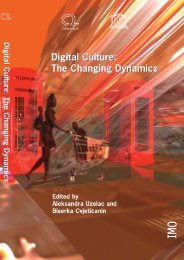free download in pdf format - Culturelink Network
free download in pdf format - Culturelink Network
free download in pdf format - Culturelink Network
Create successful ePaper yourself
Turn your PDF publications into a flip-book with our unique Google optimized e-Paper software.
Cultural Identity Politics <strong>in</strong> the (Post-)Transitional Societies<br />
starts with the 19th century memory of Ilija Garašan<strong>in</strong>’s National Programme, then the<br />
memory of Gavrilo Pr<strong>in</strong>cip (whose memory was kept as a <strong>free</strong>dom fi ghter <strong>in</strong> socialist<br />
Yugoslavia), then focus<strong>in</strong>g on the role of the Academy of Science dur<strong>in</strong>g Tito’s time (it<br />
lost credibility when it gave Tito an academic title without proper vot<strong>in</strong>g) and especially<br />
aft er his death, when the academy was obsessed with research regard<strong>in</strong>g the status of<br />
Serbs <strong>in</strong> other republics of Yugoslavia.<br />
Hundreds of “monuments” were created by Mrđan Bajić for the YugoMuseum. Th e<br />
Rambouillet castle, as a symbol of the absolute <strong>in</strong>capacity to negotiate on Kosovo and<br />
the lack of foresight as to the consequences of broken talks; Flower, as a symbol of the<br />
kitsch personality of Milošević’s wife – Mirjana Marković; Lathe, the monument to the<br />
work<strong>in</strong>g class (a mach<strong>in</strong>e which Tito knew how to use), and Poljud mean<strong>in</strong>g solidarity,<br />
friendship, brotherhood and unity. All these monuments showed how quickly society<br />
had passed from “the rule of the work<strong>in</strong>g class”, to “the rule of the nation”! But, this<br />
project can also have the title of another Mrđan Bajić art project: I did it! where the<br />
artist took responsibility for all that was happen<strong>in</strong>g on the territory of former Yugoslavia<br />
– war crimes, refugees, burned houses, ethnic cleans<strong>in</strong>g and so forth.<br />
Th e Centre for Contemporary Arts <strong>in</strong> Sarajevo developed a project called “De/<br />
construction of Monument” (2004-2006) 11 with the aim to create art works which<br />
contribute towards the deconstruction of myths and the de-ideologiz<strong>in</strong>g and decod<strong>in</strong>g<br />
of recent and distant history.<br />
Th e ma<strong>in</strong> tools <strong>in</strong> the project were monuments, symbols and icons, as the three<br />
major forms of representation of diff erent societies and historical periods. By<br />
organiz<strong>in</strong>g several debates on crucial issues, such as monuments and memory, and<br />
monuments and violence, they regrouped artists and curators who for a long time<br />
had dealt with the “monumentalization” of public spaces, such as Braco Dimitrijević<br />
(Anti-Monuments, monuments of unknown passers-by), or Sanja Iveković (Lady Rosa<br />
of Luxembourg, provok<strong>in</strong>g the Luxembourg community with her <strong>in</strong>terpretation of the<br />
First World War memorial). But the crucial debate was around artists who are rais<strong>in</strong>g<br />
contemporary Balkan issues and confront<strong>in</strong>g major monument narratives, such as<br />
Milica Tomić (the Belgrade group Spomenik/Monument), S<strong>in</strong>iša Labrović (Croatia),<br />
Sokol Beqiri (Peja, Kosovo), and those who are mak<strong>in</strong>g sarcastic comments on our<br />
contemporary memory and monument practices, such as the “Bruce Lee Monument<br />
Project” <strong>in</strong> Mostar, or the Kurt and Plasto project “By the Commssion’s decision:<br />
Everyone to one’s own”, Sarajevo 2001.<br />
Group Spomenik (Monument) <strong>in</strong>cludes Milica Tomić, Dar<strong>in</strong>ka Pop-Mitić, Nebojša<br />
Milekić, but also theoreticians such as Jasm<strong>in</strong>a Husanović and Branimir Stojanović.<br />
Each participant of the group <strong>in</strong> their <strong>in</strong>dividual artistic or theoretical work is engaged<br />
11 http://www.projekt-relations.de/en/explore/deconstruction/module/overcom<strong>in</strong>g.php<br />
42<br />
accessed 10 May 2010.



